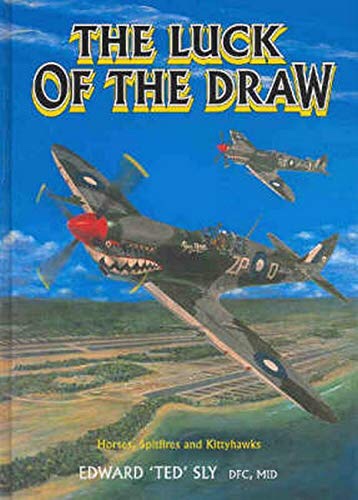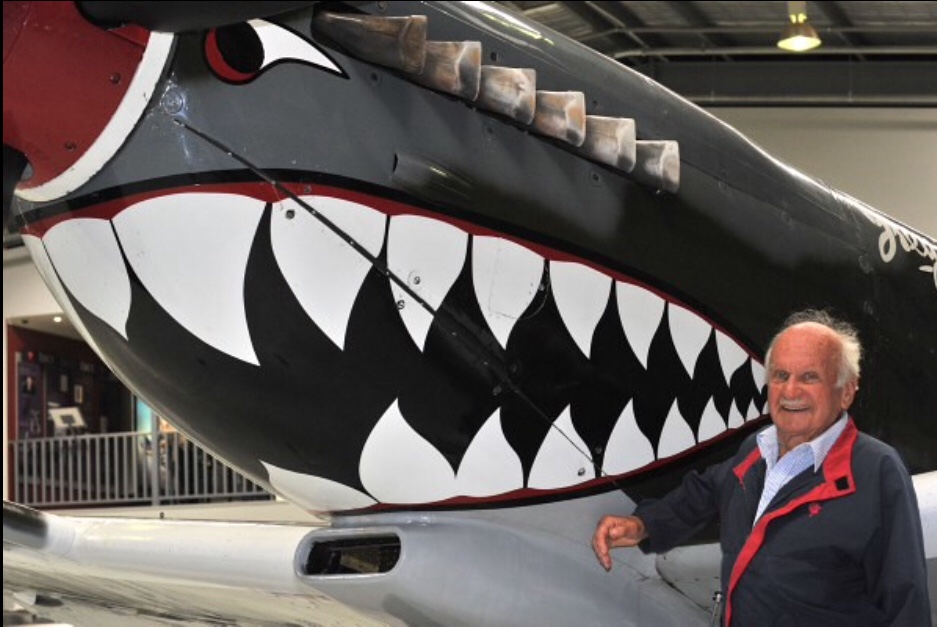“Horses, Spitfires and Kittyhawks”
Published 2003 – Author Edward ‘Ted’ Sly DFC MID

In his youth Ted Sly worked on an outback Queensland cattle station. He joined the 7th Light Horse, then the RAAF. After training in Rhodesia he served with 452 RAAF and 450 RAAF Squadrons, 92 RAF East India Squadron and as an instructor with OTU Egypt before returning to serve in the Pacific with 475 RAAF Squadron. After the war he returned to farming including a failed scheme to grow rice and breed cattle on Guadalcanal.
Ted was almost part of the furniture at the Temora Aviation Museum, where he could be found regularly signing copies of his book The Luck of the Draw. A brother-in-arms with Bobby Gibbes, Clive Caldwell, Ray Thorold-Smith, Bruce Watson, “Widge” Gleed and author Paul Brickhill, Ted made his mark flying in the defence of Australia in the Second World War.
Ted Sly, the author, is a descendant of long line of colonial families, the best known being that of explorer and builder, Sir Thomas Mitchell. Although a city boy, Ted Sly’s youth involved life with horses and work on an outback cattle station, that instilled in him a love of the rural lifestyle.
When war came, he joined the 7th Light Horse, but was soon persuaded to get away from the dirt and dust and join the RAAF. After training in Rhodesia he went to England and the 452 RAAF Squadron commanded by the famous Australian Ace, Keith ‘Bluey’ Truscott.
Next came the Middle East where he flew 22 operational sorties in Kittyhawks with 450 RAAF Squadron. Ted was next posted to 92 RAAF East India Squadron that was forming the first Spitfire Wing with the 8th Army in the Western Desert. He played a part in the El Alamein battle as his squadron followed Montgomery’s offensive, ending in Tunisia.
In 1944, he posted back to Australia and joined 457 SQN – the famous “Grey Nurses” (he was responsible for the shark’s teeth that adorned its Spitfires). He saw little combat action against Japanese aircraft but was involved in several ground attack operations. He flew his last mission in July, 1945, and discharged in February, 1946 having completed two operational tours and one as an instructor.
After several more postings until the end of the war, he came home and was married and returned to farming.
This book, primarily written as a biography of the author’s life as a record for his family is also in part, a family history of the Sly family from New South Wales and those connected to them.
Ted Sly passed away on the 30th November 2013

Biography Ted Sly
Edward Lyell Livingstone Sly was born in Oxford, UK, during April 1918. His father George, an Australian, was a cavalryman and later observer with the Royal Flying Corps in the First World War. The young Sly was born a Great Great Grandson of the explorer and engineer Sir Thomas Mitchell.
The Slys returned to Australia, and in his teenage years Ted had a short-lived career in banking in Sydney before turning his hand to jackeroo work near Charters Towers and then to a sheep station near Gunnedah. At the outbreak of the second war in Europe in less than 25 years, Ted enlisted in the 7th Light Horse before lured into an RAAF career. It was a career path that echoed that of his father’s military service.
Under the Empire Air Training Scheme, he did his flight training at 1IFTS Lindfield and in Southern Rhodesia. It was here that fate dealt Ted a favourable turn. The night before graduation as a Sergeant Pilot, he was unexpectedly promoted to Pilot Officer, meaning his posting in the RAF switched from Singapore to the UK. Most of the pilots who went to Singapore were killed trying to resist the Japanese with Brewster Buffaloes or were captured when the island capitulated.
Among those who introduced Ted to Spitfire operations were Australian Tony Gaze and “Bluey” Truscott, CO at Ted’s first operational squadron, 452 Sqn RAAF. He wasn’t there long before another posting took him into North Africa to fly P-40 Kittyhawks with 450 squadron and his first combat sortie; a “Stuka Party” intercepting Ju87 divebombers.
“One of the most important ‘training’ exercises for a fighter pilot was his first combat experience,” Sly would later write in The Luck of the Draw. “There was no textbook or training exercise that adequately prepared us for someone using their guns and cannon on our aircraft.
“Operational flying to escort convoys and searching for enemy positions were all static roles compared to combat, which occurred in seconds and in no time, was over.”
Most of Ted’s flying in North Africa was with 92 Sqn RAF on MkV Spitfires fitted with Vokes filters. He flew in support of the Battle of El Alamein and the push to drive Rommel’s Afrika Korps out of Cyrenaica and back to Tripoli. On one mission his aircraft was holed, he believed, by the German ace Hans-Joachim Marseille.
Ted’s time in the desert ended in 1944, when he was posted back to Australia. He wanted to remain with the RAF, but HQ RAAF was beckoning and before long he was with 2 Operational Training Unit at Mildura. That gave him a chance to reunite with Bobby Gibbes, who he had met during his days with 450 Sqn.
With his combat experience, Ted was a logical choice to take up a role as Flight Commander with 457 Sqn at Batchelor. 457 was part of 90 Wing, under the command of Group Captain Caldwell, another North Africa veteran, with Bobby Gibbes as Wing Commander. It was Sly’s idea to borrow the shark mouth concept from 112 Sqn RAF that ended with the squadron nick-named Grey Nurse. The paint scheme survives today on the Temora Aviation Museum’s Spitfire, which is painted in Bobby Gibbes’ markings.
This posting took Ted to several bases throughout the South Pacific as the Japanese were forced back: Moratai, Labuan and the Phillippines. It was at Clark Field that Ted and other 457 pilots flew their Spitfires in trials against captured and rebuilt Japanese fighters. The US Army Air Force had requested 90 Wing to assist with the advance to Okinawa, but HQ RAAF had refused, leaving the wing effectively doing mopping up operations.
Post-war, Ted married Irene Bettington and the two turned to a farming life, raising a family on property near Gunnedah. Later, he returned to the South Pacific, trying his hand at rice farming on Guadalcanal.
But according to Bobby Gibbes, Ted Sly’s greatest achievement is the “living memorial” to the Spitfires of WWII. Ted established a fund that is now known as the Spitfire Memorial Defence Fellowship at the University of NSW and the ADF Academy.
In his later years, Ted Sly penned his autobiography The Luck of the Draw, and reveled in watching the Grey Nurse Spitfire flying at Temora Aviation Museum.
He truly was a great exponent of Supermarine’s magnificent creation.

Flying Again at 90
The adage that “an old dog can’t be taught new tricks” was not the case for FLT LT Ted Sly (ret’d) on his 90th birthday when he flew solo for the first time since stepping out of his Spitfire at the end of World War II. He has subsequently flown several times.
Late in 2007, Mr. Sly visited his local doctor for an annual medical check-up and was informed (hat he had the reflexes of a man decades younger. He decided to take to the skies again and contacted a local flying school. Three months and several hours later, he achieved his second solo flight; 67 years after his first.
He said it “was terrific” to be flying again.
Edward Sly was born on April 27, 1918, in Oxford, UK. His family returned to Australia in 1919. After leaving school in 1933, he began a career with a bank and then as a jackeroo.
With the outbreak of war, on October 14, 1940, he enlisted in the RAAF. He was taken up in the Empire Air Training Scheme and, promoted to SGT, posted to Rhodesia (now Zimbabwe) for his flying training. After soloing, he was promoted to PLTOFF and posted to Canada for more advanced training.
After arriving in the UK at the end of 1941, he soloed on Spitfires and was posted to 452SQN in the UK, then to 450SQN flying Kittyhawks in the Middle East and then to 92SQN (RAF), again flying Spitfires.
Ted flew with another author, Paul Brickhill (Reach for the Sky) and Ted tells the story that Paul was a far better writer than he was a pilot. He can well remember Brickhill being shot down in North Africa and eventually being interned by the Jerries. While all this was happening Ted was circling far above in his Spitfire hoping that Paul would be rescued on crash landing, by the Allies, alas this was not to be. And with a heavy heart Ted turned away when he saw a German Tank crew collar the English pilot.
A story about our side doing the same thing was told by Ted. A German fighter pilot in a Spitfire. Neville Duke had shot down the German plane; the pilot had bailed out and was picked up by the British Army police who had witnessed the action, with the rule that any interrogation of the pilot was to take place as soon as captured, when the pilot was in a state of shock. The Desert Police were very appreciative of our operations and did us a favour when I placed the German pilot in the cockpit of the Spitfire. I had some armed airmen handy just in case of any attempt by the German pilot to start up and take off.
In 1944, he posted back to Australia and joined 457 SQN – the famous “Grey Nurses” (he was responsible for the shark’s teeth that adorned its Spitfires). He saw little combat action against Japanese aircraft but was involved in several ground attack operations. He flew his last mission in July, 1945, and discharged in February, 1946.
Ted Sly decided not to continue flying. Nevertheless, he retained a keen interest in all matters aviation.
He started back on the land, firstly in NSW, then in the Solomon Islands, Fiji and Vanuatu. In 1975, he returned to northern NSW for some years, before retiring to Ballina.
Ted Sly’s last venture occurred in 1996, when, at a meeting of the Spitfire Association, a group of former pilots decided to raise money for a ‘living memorial’ to the memory of all those who flew Spitfires. As a result, in 1998, the Spitfire Memorial Defence Fellowship was launched at ADFA. The Fellowship grant was to be given to support (under stringent selection criteria) study in Defence related subjects at the University of New South Wales or the Academy.
“This has been a great achievement of Ted’s; as the memory of the Spitfire aircraft and the men who served will be remembered long after the last man has faded away., said Spitfire Association Secretary Steve McGregor.


Ted Sly Decorations
DFC, MID
Campaign Stars
1939-45 Star, Africa Star and Clasp, Pacific Star, Italy Star
War Medals
Defence Medal, War Medal 1939-45
Arriving in Darwin in 1944, Ted was after Bill Hinds time and from July that year they now flew more advanced Mk VIII Spitfires.
See Biographies on Ted Sly at the Temora Aviation Museum and Australian Spitfire Association websites.